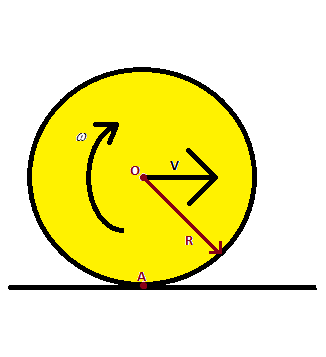
The ratio of its rotational kinetic energy and translational kinetic energy of a sphere, which is rolling without slipping on a horizontal plane, will be:
(A) $5:2$
(B) $2:5$
(C) $7:5$
(D) $5:7$
Answer
140.4k+ views
Hint The kinetic energy of the body is the sum of its rotational kinetic energy and the translational kinetic energy about the center of mass of the rigid sphere. Here the center of mass is at the point $O$. Also, it has been given that there is no slip, i.e. the relative velocity of the point $A$ on both the sphere and the ground $0$. Therefore we have $v = \omega R$.

Complete Step by step solution We will separately calculate the rotational kinetic energy and translational kinetic energy and find their ratios. The rotational energy of any body is given by $\dfrac{1}{2}I{\omega ^2}$, where $I$ is the mass moment of inertia, and $\omega $ is the angular velocity about the center of mass of the body $O$.
This energy will vary with different objects as for various objects, the moment of inertia $I$ will vary.
For this solid sphere, $K.E{._{rotational}} = \dfrac{1}{2}I{\omega ^2} = \dfrac{1}{2}(\dfrac{2}{5}M{r^2}){\omega ^2}$
Therefore, substituting $v = \omega R$ in $K.E{._{rotational}} = \dfrac{1}{2}I{\omega ^2} = \dfrac{1}{2}(\dfrac{2}{5}M{r^2}){\omega ^2}$, we get
$ \Rightarrow K.E{._{rotational}} = \dfrac{1}{2}(\dfrac{2}{5}M{r^2}){(\dfrac{v}{r})^2}$,
$ \Rightarrow K.E{._{rotational}} = \dfrac{1}{5}M{v^2}$, where $v$ is the translational velocity at the center of mass of the body $O$.
Now we will find the translational kinetic energy of the solid sphere.
Translational kinetic energy is given by $K.E{._{translational}} = \dfrac{1}{2}M{v^2}$
Now the ratio of the rotational kinetic energy to the translational kinetic energy is, $\dfrac{{K.E{._{rotational}}}}{{K.E{._{translational}}}} = \dfrac{{\dfrac{1}{5}M{v^2}}}{{\dfrac{1}{2}M{v^2}}} = \dfrac{2}{5}$
Hence the correct answer is an option (B).
Note Here we consider the sphere as a solid body. If the sphere would have been hollow, then the moment of inertia would be $\dfrac{{2M{R^2}}}{3}$, in which case the answer would be $\dfrac{{K.E{._{rotational}}}}{{K.E{._{translational}}}} = \dfrac{{\dfrac{1}{3}M{v^2}}}{{\dfrac{1}{2}M{v^2}}} = \dfrac{2}{3}$. The velocity at the contact between the ground and the sphere is $0$ and at the top, most point of the sphere is $v + R\omega $, which is equal to $2v$ , and is the fastest moving point on the sphere.

Complete Step by step solution We will separately calculate the rotational kinetic energy and translational kinetic energy and find their ratios. The rotational energy of any body is given by $\dfrac{1}{2}I{\omega ^2}$, where $I$ is the mass moment of inertia, and $\omega $ is the angular velocity about the center of mass of the body $O$.
This energy will vary with different objects as for various objects, the moment of inertia $I$ will vary.
For this solid sphere, $K.E{._{rotational}} = \dfrac{1}{2}I{\omega ^2} = \dfrac{1}{2}(\dfrac{2}{5}M{r^2}){\omega ^2}$
Therefore, substituting $v = \omega R$ in $K.E{._{rotational}} = \dfrac{1}{2}I{\omega ^2} = \dfrac{1}{2}(\dfrac{2}{5}M{r^2}){\omega ^2}$, we get
$ \Rightarrow K.E{._{rotational}} = \dfrac{1}{2}(\dfrac{2}{5}M{r^2}){(\dfrac{v}{r})^2}$,
$ \Rightarrow K.E{._{rotational}} = \dfrac{1}{5}M{v^2}$, where $v$ is the translational velocity at the center of mass of the body $O$.
Now we will find the translational kinetic energy of the solid sphere.
Translational kinetic energy is given by $K.E{._{translational}} = \dfrac{1}{2}M{v^2}$
Now the ratio of the rotational kinetic energy to the translational kinetic energy is, $\dfrac{{K.E{._{rotational}}}}{{K.E{._{translational}}}} = \dfrac{{\dfrac{1}{5}M{v^2}}}{{\dfrac{1}{2}M{v^2}}} = \dfrac{2}{5}$
Hence the correct answer is an option (B).
Note Here we consider the sphere as a solid body. If the sphere would have been hollow, then the moment of inertia would be $\dfrac{{2M{R^2}}}{3}$, in which case the answer would be $\dfrac{{K.E{._{rotational}}}}{{K.E{._{translational}}}} = \dfrac{{\dfrac{1}{3}M{v^2}}}{{\dfrac{1}{2}M{v^2}}} = \dfrac{2}{3}$. The velocity at the contact between the ground and the sphere is $0$ and at the top, most point of the sphere is $v + R\omega $, which is equal to $2v$ , and is the fastest moving point on the sphere.
Recently Updated Pages
Difference Between Circuit Switching and Packet Switching

Difference Between Mass and Weight

JEE Main Participating Colleges 2024 - A Complete List of Top Colleges

JEE Main Maths Paper Pattern 2025 – Marking, Sections & Tips

Sign up for JEE Main 2025 Live Classes - Vedantu

JEE Main 2025 Helpline Numbers - Center Contact, Phone Number, Address

Trending doubts
JEE Main 2025 Session 2: Application Form (Out), Exam Dates (Released), Eligibility, & More

JEE Main 2025: Derivation of Equation of Trajectory in Physics

JEE Main Exam Marking Scheme: Detailed Breakdown of Marks and Negative Marking

Learn About Angle Of Deviation In Prism: JEE Main Physics 2025

Electric Field Due to Uniformly Charged Ring for JEE Main 2025 - Formula and Derivation

JEE Main 2025: Conversion of Galvanometer Into Ammeter And Voltmeter in Physics

Other Pages
Units and Measurements Class 11 Notes: CBSE Physics Chapter 1

JEE Advanced Marks vs Ranks 2025: Understanding Category-wise Qualifying Marks and Previous Year Cut-offs

NCERT Solutions for Class 11 Physics Chapter 1 Units and Measurements

Motion in a Straight Line Class 11 Notes: CBSE Physics Chapter 2

Important Questions for CBSE Class 11 Physics Chapter 1 - Units and Measurement

NCERT Solutions for Class 11 Physics Chapter 2 Motion In A Straight Line




